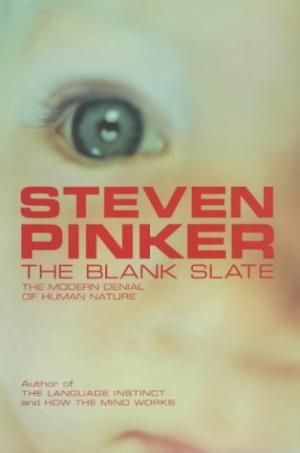The Blank Slate: The Modern Denial of Human Nature
In The Blank Slate, Steven Pinker explores the idea of human nature and its moral, emotional, and political colorings. He shows how many intellectuals have denied the existence of human nature and instead have embraced three dogmas: The Blank Slate (the mind has no innate traits), The Noble Savage (people are born good and corrupted by society), and The Ghost in the Machine (each of us has a soul that makes choices free from biology).
In The Blank Slate, Steven Pinker explores the idea of human nature and its moral, emotional, and political colorings. He shows how many intellectuals have denied the existence of human nature and instead have embraced three dogmas: The Blank Slate (the mind has no innate traits), The Noble Savage (people are born good and corrupted by society), and The Ghost in the Machine (each of us has a soul that makes choices free from biology). Each dogma carries a moral burden, so their defenders have engaged in desperate tactics to discredit the scientists who are now challenging them.
Pinker provides calm in the stormy debate by disentangling the political and moral issues from the scientific ones. He shows that equality, compassion, responsibility, and purpose have nothing to fear from discoveries about an innately organized psyche. Pinker shows that the new sciences of mind, brain, genes, and evolution, far from being dangerous, are complementing observations about the human condition made by millennia of artists and philosophers. All this is done in the style that earned his previous books many prizes and worldwide acclaim: irreverent wit, lucid exposition, and startling insight on matters great and small.
| Author | Steven Pinker |
|---|---|
| Publisher | Penguin Books |
| Place | London |
| Year | 2003-06-05 |
| ISBN | 9780140276053 |
| Binding | Paperback |
| Condition | Good |
| Comments | Fold on front cover, yellowed pages |
How we describe the condition of our books
We are very proud of the condition of the books we sell (please read our testimonials to find out more!)
New: Exactly as it says.
As New: Pretty much new but shows small signs of having been read; inside it will be clean without any inscriptions or stamps; might contain a remainder mark.
Very Good: Might have some creases on the spine; no hard cracks; maybe slight forward lean and short inscription inside; perhaps very minor bumping on the corners of the book; inside clean but the page edges might be slightly yellowed.
Good: A few creases on the spine, perhaps a forward lean, bumping on corners or shelfwear; maybe an inscription inside or some shelfwear or a small tear or two on the dustjacket; inside clean but page edges might be somewhat yellowed.
Fair: In overall good condition, might have a severe forward lean to the spine, an inscription, bumping to corners; one or two folds on the covers and yellowed pages; in exceptional cases these books might contain some library stamps and stickers or have neat sticky tape which was used to fix a short, closed tear.
Poor: We rarely sell poor condition books, unless the books are in demand and difficult to find in a better condition. Poor condition books are still perfect for a good read, all pages will be intact and none threatening to fall out; most probably a reading copy only.


